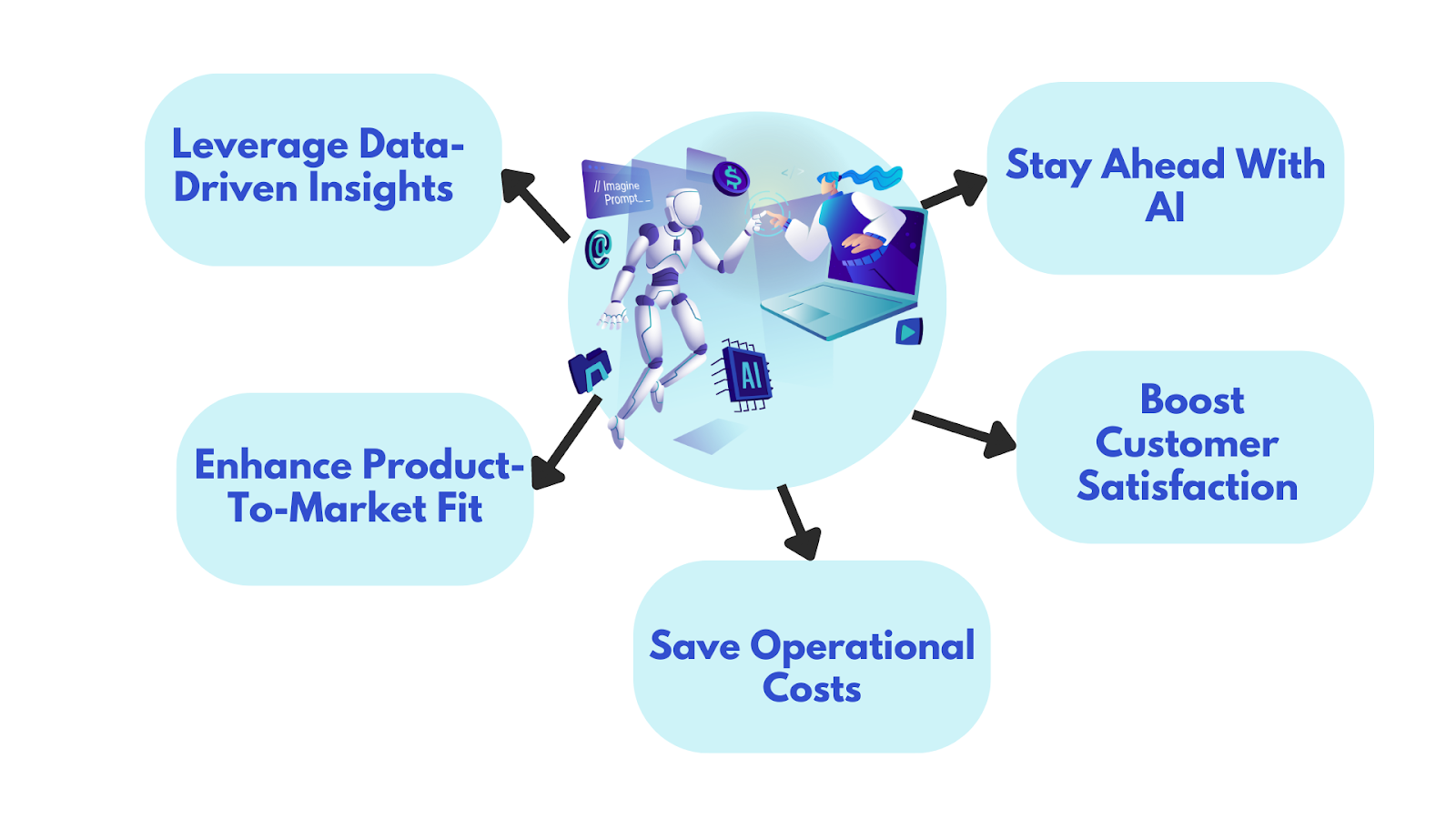The quest to leverage AI in the service industry is not just a futuristic vision—it’s the present-day imperative. With tools like ChatGPT spearheading the AI revolution, the intricate dance between deep learning and robust natural language processing radically reshapes industries’ operations. From startups to global conglomerates, the enthusiasm to integrate AI is palpable, and those not on this journey risk being left behind.

As a decision-maker at the helm of innovation in your enterprise, the allure of AI extends beyond mere technological advancement. It’s about harnessing AI-driven digitalization to elevate business outcomes and meet evolving consumer expectations. As of 2021 research statistics, 25% of worldwide industries actively explore ways to adopt AI.

Throughout this article, we will explore the multifaceted potential of AI in the service sector, especially how it paves the way for technology adoption in a world undergoing rapid digitalization. We’ll align our focus with an AI strategy tailored for the service domain, providing you with a roadmap to navigate this transformative journey.
Why It Is Crucial to Use AI in the Service Industry

It’s evident that AI is steadily becoming a cornerstone of modern business. But what makes it especially essential for the service industry at this moment? Here are the top five reasons:
Leverage Data-Driven Insights
Harnessing AI allows businesses to dive deep into vast data pools, extracting valuable insights that can significantly enhance service quality. This ensures better user experiences and positions companies as frontrunners in delivering top-notch services in their niche.
Enhance Product-To-Market Fit
AI-powered analytics fine-tune product offerings, aligning them closely with market demands. By gauging consumer behavior and preferences, businesses can tailor their products, ensuring they resonate profoundly with the target audience, resulting in increased adoption.
Save Operational Costs
The ability of AI to automate repetitive tasks and predict potential challenges significantly reduces operational overheads. Companies can drive efficiency while cutting unnecessary costs through predictive maintenance, stock optimization, and intelligent resource allocation.
Boost Customer Satisfaction
Personalization is the hallmark of contemporary service delivery. AI excels in tailoring services to individual user needs, guaranteeing heightened customer satisfaction. Businesses can foster deeper relationships and loyalty by anticipating client needs and providing bespoke solutions.
Stay Ahead With AI
In today’s fast-paced digital era, leveraging AI is no longer optional but necessary. Adopting AI-driven strategies ensures businesses stay ahead of competitors, continually innovate, and maintain their position as industry leaders, setting benchmarks others aspire to reach.
How to Laydown Data and Infrastructure in AI Adoption for the Service Industry

Adopting AI in the service industry isn’t merely about algorithms and cutting-edge technology; it’s also about laying down a strong foundation of data and infrastructure to support and drive these technologies. Here’s a closer look at the crucial components:
The Importance of Data Retrieval and Strategy in AI
Data is the lifeblood of AI. Without a strategy for retrieving and managing this data, AI tools lack the fuel they need. The correct data retrieval strategy focuses on gathering relevant, timely, and diverse data sources, ensuring that AI models are trained on the most accurate and comprehensive datasets.
Bridge Legacy Systems With Modern AI Solutions
While rich in data, legacy systems often need more flexibility to integrate with the latest AI solutions. Bridging these systems with modern AI tools requires a blend of adapters, middleware, and often custom coding to ensure seamless data flow and real-time processing capabilities.
Choose Between Cloud Platforms
Cloud platforms offer scalable, flexible, and cost-effective infrastructure for AI deployments. AWS, Azure, and Google Cloud each provide unique tools and services tailored for various AI use cases.
While choosing, consider factors such as pricing, regional availability, specific AI services, and compatibility with existing systems. For those wanting to rely on something other than a single vendor, hybrid systems offer an amalgamation of multiple platforms, ensuring redundancy and optimal performance.
Build a Robust Machine-Learning Infrastructure for Scalable Solutions
AI’s true potential is realized when it can scale. A robust machine-learning infrastructure considers the initial deployment and how the solution will scale as data grows and demands increase. This involves using modular architectures automated training pipelines, and ensuring the infrastructure can handle iterative model training and deployment.
Prioritizing Data Quality and Collection
Quality over quantity always holds for data in AI. Prioritizing data quality means ensuring the data feeding into AI models is free from biases, inaccuracies, and redundancies. Regular audits, data cleansing routines, and data validation strategies are vital to maintaining data quality.
Scalable Infrastructure: The Bedrock of AI Implementation
The success of AI initiatives is significantly tethered to the scalability of the infrastructure in place. As AI models evolve and businesses grow, the infrastructure must adapt without hitches. Embracing containerization, serverless computing, and adopting distributed architectures are ways to ensure a future-proof, scalable AI infrastructure.
What Are Some Key Challenges Service Industries Face When Adopting AI

While AI promises transformative potential for the service industry, its adoption is riddled with challenges that organizations must acknowledge and address. Here’s a dive into some of the significant hurdles faced:
Navigating the Cultural and Technological Shifts
As with any major technological disruption, AI brings about a significant shift in both company culture and technological paradigms. Employees, from frontline staff to management, must have the right mindset. A Company culture of change is essential to promote AI evangelism and ensure trust in AI’s capabilities and potential.
Overcoming Data Strategy Hurdles: Fragmented IT Systems and Data Retrieval Issues
Legacy IT systems can be a double-edged sword. While they house vast amounts of data, their fragmentation often poses data retrieval and integration challenges. Establishing a coherent data retrieval and strategy becomes paramount to feed AI systems with the right data and garnering data-driven insights.
Striking the Right Balance: Technical Feasibility vs. Business ROI
It’s tempting to jump onto the AI bandwagon, but assessing the technical feasibility of any AI initiative against its expected business returns is crucial. Service industries must ensure their AI strategy aligns well with their business models and brings value.
Technical Complexities and Integration Issues
The path to AI adoption is technical and intricate. Integrating AI solutions, especially with existing systems and processes, can lead to unforeseen complexities. Issues ranging from integrating the Internet of Things to ensuring seamless AI scheduling can pose challenges. A robust Change Management System can be pivotal in handling these complexities.
Ethical Considerations in AI Deployments

AI, especially in service industries, touches upon sensitive data. Ethical dilemmas, from AI model biases to data privacy concerns, need addressing. Businesses must stay updated on best practices and ethical standards, ensuring their AI initiatives enhance customer satisfaction without compromising ethics.
The Challenge of Talent Acquisition and Retention
The demand for AI expertise vastly outstrips the supply. Service industries often need help to acquire the right engineering talent in AI. Beyond recruitment, the rapid evolution of AI means businesses must invest in progressive training and ensure an environment conducive to knowledge sharing to retain top talent.
10 Ways to Adopt AI in the Service Industry

The rise of AI in the service industry has opened many opportunities. Yet, with these opportunities come choices. Which AI path to traverse? How do you ensure the chosen AI strategy aligns with your industrial goals? Here are 10 comprehensive ways to help you make informed decisions in your AI journey:
Recognize the Most Pressing Business Challenges With AI
Understanding your business challenges is the foundational step before diving into AI. To leverage the power of AI in service industries, one must first discern the inefficiencies and loopholes in their current systems.
AI has the potential to tackle these challenges head-on, from the realm of customer service inventory management to real-time data analytics. By recognizing these business challenges, you pave the way for targeted AI solutions that address specific pain points, ensuring that the technology serves a defined, essential purpose.
Prioritize Use Cases and Pilot Them Effectively
Once the challenges have been identified, the next step is to prioritize AI use cases that align with these challenges. It’s tempting to chase after the latest AI trend or innovation, but what’s crucial is the relevance of these AI solutions to your specific business context. Piloting these solutions becomes paramount.
Before scaling up, a controlled, smaller-scale test allows businesses to gauge the effectiveness of the chosen AI solution, making necessary adjustments and ensuring the implementation’s success when rolled out on a larger scale.
Cultivate an AI Culture: Knowledge Sharing and AI Evangelism
The technical implementation of AI is just one side of the coin. The other often overlooked aspect is cultivating an AI culture within the organization. This involves promoting a continuous learning attitude and innovation.
With AI continually evolving, knowledge sharing becomes essential. Businesses can harness collective intelligence by ensuring that successes, challenges, and insights are shared across teams, driving AI initiatives with a unified vision.
Coupled with this is the role of AI evangelism. Passionate champions of AI within the organization can motivate, educate, and drive AI adoption, ensuring its potential is realized to the fullest.
Expand AI Initiatives Beyond Pilot Cases
Piloting AI solutions is critical, but true value emerges when these solutions are expanded beyond initial tests. With the insights gained from pilot cases, organizations are better equipped to integrate AI into more significant, often more complex scenarios.
This means refining algorithms based on larger data sets, extending AI functionalities to interconnected departments and ensuring scalable solutions. The move from pilot to full-blown implementation can be challenging, but it’s where the transformative power of AI is genuinely felt, driving greater efficiency, innovation, and competitive advantage.
Establish AI/ML User Groups for Collaborative Growth
AI and ML are not just the domain of tech experts; their success often hinges on collaboration across different facets of an organization. By establishing AI/ML user groups, companies can foster a space for cross-functional collaboration, where diverse teams – from tech experts to customer service reps – can share insights, challenges, and best practices.
Such groups serve as melting pots of ideas, ensuring that AI initiatives are holistic, grounded in real-world challenges, and, most importantly, collaborative. They can also serve as forums for continuous learning, with members updating each other on the latest AI trends, tools, and methodologies.
Structure the Organization to Fuel AI Transformation With Centralized AI Hubs
An essential aspect of driving AI transformation is the organizational structure. Centralized AI hubs – dedicated teams or departments focused on AI – can streamline efforts, consolidate expertise, and drive initiatives with a singular vision.
These hubs can serve as the epicenter of AI strategy, development, and deployment, ensuring that efforts are cohesive and cohesive. Businesses can provide a coherent AI strategy, faster decision-making, and a clear communication channel by centralizing AI expertise and resources.
Such hubs can also interface with other departments, ensuring that AI initiatives align with broader organizational goals and strategies.
Build Continuously on AI Successes and Adapt to Change
In the rapidly evolving landscape of AI, resting on one’s laurels isn’t an option. Every success with an AI implementation should be seen as a stepping stone to the next significant achievement. Lessons learned from successful AI projects can provide valuable insights into refining methodologies, tools, and strategies for future initiatives.
Moreover, the AI realm is subject to constant change – new algorithms, tools, and best practices emerge regularly. Businesses must be agile, adapting their AI strategies and initiatives to leverage these advancements and stay ahead of the competition.
Prioritize Flexibility and Scalability
As organizations grow and their needs evolve, AI solutions must grow with them. Implementing flexible AI systems that can adapt to changing business requirements is essential. Moreover, scalability is crucial.
As data volumes increase and computational needs grow, AI solutions should be capable of handling this surge without a drop in performance or efficiency. Investing in modular and scalable architectures ensures businesses can expand their AI capabilities without major overhauls or disruptions.
Seek Feedback From Stakeholders and Employees
The true test of any AI initiative’s effectiveness lies in its real-world application. Stakeholders, ranging from top-tier management to ground-level employees, can offer invaluable feedback on an AI system’s utility, efficiency, and areas of improvement.
Creating channels for regular feedback ensures that AI solutions remain aligned with business goals and user needs. Moreover, by involving employees in the feedback loop, organizations can foster a sense of ownership and inclusivity, driving better adoption and more successful AI implementations.
Ensure Vendor Support and Continuous Updates
The relationship with AI solution vendors should continue post-implementation. Ongoing vendor support is crucial to address any technical challenges, system optimizations, or updates that might arise. With the AI domain advancing quickly, system updates are frequent and necessary to leverage the latest tools, algorithms, and best practices.
A solid collaboration with suppliers guarantees that companies consistently have the newest AI features and that any system issues or hurdles are promptly resolved. This ensures the longevity, relevance, and efficiency of the AI solutions.
Successful Use Cases of AI Adoption in the Service Industry

Undoubtedly, AI has made significant strides in reshaping the service industry. To further illustrate the transformative power of AI, let’s examine some standout use cases from the sector:
AI Scheduling Leading To Optimized Service Delivery
Example: Healthcare Appointment Systems
In the healthcare sector, AI-driven scheduling tools have made significant impacts. For instance, the Mayo Clinic implemented an AI scheduling system to match patients’ better needs with the right specialists while considering doctor availability. This reduced patient wait times and optimized the doctors’ schedules, ensuring a balanced workload and improved service delivery.
Integration With the Internet of Things for Proactive Service Response
Example: Smart Home Maintenance
Companies like Nest and Honeywell use IoT-integrated AI systems for home maintenance. These smart thermostats learn homeowner preferences over time and adjust heating or cooling for optimal comfort. Furthermore, they can predict when a system will fail and proactively alert homeowners or service providers, leading to timely maintenance and reduced downtime.
Chatbots: Revolutionizing Customer Support
Example: Banking Sector Chatbots
Many banks, including Bank of America with its chatbot “Erica,” have harnessed the power of AI to offer instant, round-the-clock customer support. Erica assists millions of customers with tasks like checking balances, scheduling payments, and providing financial advice, leading to increased customer satisfaction and significant operational cost savings.
AI in Supply Chain: Predictive Analysis and Optimization
Example: Walmart’s Supply Chain Enhancement
A global retail giant, Walmart utilizes AI to predict demand, fine-tune inventory, and enhance supply chain operations. The company predicts which products will be in demand through machine learning based on factors like seasonality, market trends, and historical sales data. This ensures shelves are always stocked with the right products, reducing waste and maximizing sales.
Personalized Recommendations: AI in Retail and E-commerce
Example: Amazon’s Recommendation Engine
Amazon, the e-commerce giant, employs AI-driven algorithms to provide users with product recommendations based on their browsing history, purchase history, and items in their cart. This personalized shopping experience increases sales for Amazon and enhances customer satisfaction as users find products tailored to their preferences and needs.
Tips & Tricks to Adopt AI in the Service Industry

Integrating AI into the service industry demands combining technology expertise and strategic foresight. Discover actionable insights to ensure successful AI adoption, fostering growth, and maintaining a competitive edge in today’s evolving business landscape.
Investing in Progressive Training for Staff
As AI introduces new workflows and tools, continuous training becomes pivotal. This doesn’t mean sending your entire team to week-long conferences but implementing ongoing, bite-sized training sessions. For instance, tools like Coursera or Udemy offer industry-specific courses that can elevate your team’s AI literacy. Progressive training ensures that your staff isn’t just acquainted with AI but becomes proficient in leveraging its capabilities.
Capitalizing on the Strength of Early Adopters Within the Organization
Every organization has its set of tech enthusiasts eager to explore new tools. These early adopters are invaluable when rolling out AI initiatives. By identifying and empowering these individuals, companies can establish internal AI champions who can inspire others and act as a resource for those struggling with the transition. They can also provide genuine feedback from the frontlines, helping fine-tune AI strategies.
Start Small and Scale Gradually
AI adoption doesn’t mean a complete overhaul of existing systems overnight. Start with pilot projects. For instance, if you’re in the hospitality industry, you might begin by implementing an AI chatbot for customer inquiries on your website. Once you’ve gauged its success and addressed any challenges, you can consider more expansive projects like predictive analytics for room bookings or AI-driven facility management.
Foster a Culture of Continuous Learning
AI keeps evolving. Encourage a culture where employees are curious, ask questions, and keep yourself updated. Regular workshops, seminars, or AI-focused newsletters can keep the team informed. Promoting an environment of growth and curiosity ensures that the company remains adaptable and forward-thinking.
Embrace Failures as Learning Opportunities
AI adoption comes with challenges; only some initiatives will yield the desired outcomes. However, failures are an integral part of the learning curve. Instead of viewing them as setbacks, treat them as invaluable feedback. Analyze what went wrong, make necessary adjustments, and iterate. By fostering a mindset where failures are stepping stones to improvement, companies can navigate the complexities of AI adoption with resilience and determination.
Conclusion
The infusion of AI into the service industry isn’t just a fleeting trend—it’s an evolutionary leap promising unparalleled efficiency, customization, and transformative capabilities. Beyond the algorithms and data-driven insights, the real essence of AI adoption lies in its ability to reshape traditional processes, anticipate customer needs, and future-proof businesses. Without question, traversing this technological landscape has its obstacles. However, with the proper approaches and a flexible mindset, industries can transform these hurdles into avenues for expansion and ingenuity.
FAQs
How will AI impact customer service?
AI enhances customer service by offering instant responses, personalizing experiences, and automating repetitive tasks.
Which industry uses AI the most?
Healthcare, finance, and e-commerce are among the top industries extensively leveraging AI.
What everyday services rely on AI?
Everyday services like online search engines, virtual assistants, and recommendation algorithms on streaming platforms use AI.
What is an AI platform as a service?
AI platform as a service (PaaS) is a cloud-based platform offering AI toolsets and computational resources for AI model development and deployment.
How many companies use AI in customer service?
A growing number of companies, estimated at over 40%, are integrating AI into their customer service operations to enhance responsiveness and efficiency.
What is the most common type of AI used today?
Machine learning, profound learning, is the most prevalent AI technique utilized in modern applications.

